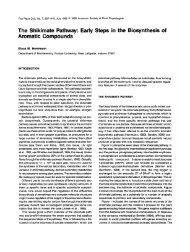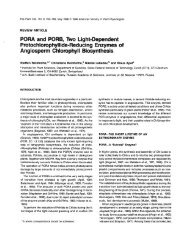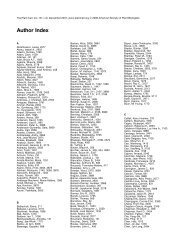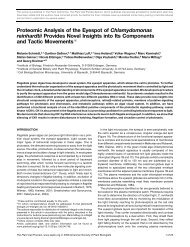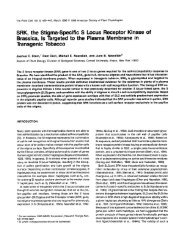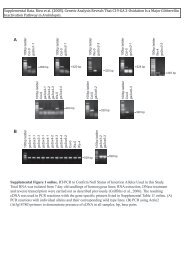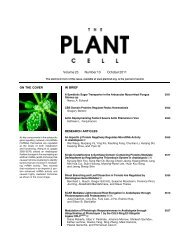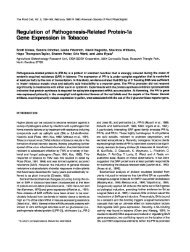The Angiosperm Gibberellin-GID1-DELLA Growth ... - The Plant Cell
The Angiosperm Gibberellin-GID1-DELLA Growth ... - The Plant Cell
The Angiosperm Gibberellin-GID1-DELLA Growth ... - The Plant Cell
You also want an ePaper? Increase the reach of your titles
YUMPU automatically turns print PDFs into web optimized ePapers that Google loves.
4 of 12 <strong>The</strong> <strong>Plant</strong> <strong>Cell</strong><br />
mutant alleles of which confer the pea slender phenotype upon<br />
which the original inhibitor of an inhibitor hypothesis was based<br />
(Brian, 1957), correspond to <strong>DELLA</strong>-encoding genes (Weston<br />
et al., 2008).<br />
<strong>The</strong> molecular characterization of the Arabidopsis gai mutation<br />
highlighted the importance of the <strong>DELLA</strong> domain (Figure 2A;<br />
Peng et al., 1997). This importance was further emphasized in<br />
studies of the GA insensitivity of dwarfing mutants of maize (D8-1;<br />
D8-2023) and wheat (Rht-B1b). As with gai, the GA insensitivity of<br />
these mutants is conferred by mutant <strong>DELLA</strong>s that lack functional<br />
conserved N-terminal domains, termed <strong>DELLA</strong> (domain I) or<br />
TVHYNPS (domain II) (Figure 2B; Peng et al., 1999a). Further<br />
studies identified domain I or domain II mutations in GA-insensitive<br />
barley (Hordeum vulgare) and rice (Oryza sativa) mutants (Chandler<br />
et al., 2002; Asano et al., 2009). In addition, deletion of domain<br />
IofArabidopsis RGA (as conferred by the rga-D17 transgene)<br />
results in a mutant RGA protein (rga-D17) that, similarly to gai,<br />
confers GA-insensitive dwarfism (Dill et al., 2001). Thus, in a<br />
general sense, mutation of domain I or II of <strong>DELLA</strong>s can prevent<br />
GA opposability and confers GA-insensitive dwarfism. We will<br />
return to the biological functions of domains I and II later in this<br />
review.<br />
<strong>The</strong> wheat Rht-B1b (and Rht-D1b) alleles are important in<br />
modern agriculture, in that they confer the increased grain yields<br />
of the green revolution varieties containing them (Peng et al.,<br />
1999a). In attempts to further expand the agricultural utility of<br />
domain I mutant <strong>DELLA</strong>s, the Arabidopsis gai gene was shown to<br />
confer dwarfism when expressed in basmati rice (Peng et al.,<br />
1999a; Fu et al., 2001), and a switchable form of gai was<br />
developed that can be used to induce growth restraint flexibly<br />
as and when required (Ait-ali et al., 2003).<br />
In summary, wild-type <strong>DELLA</strong>s were identified as GA-opposable<br />
plant growth inhibitors that can be specifically mutated (in<br />
domains I and/or II) to become growth inhibitors that are resistant<br />
to the effects of GA. However, the mechanism via which GA<br />
overcomes the growth inhibitory effects of wild-type <strong>DELLA</strong>s was<br />
unknown.<br />
GA PROMOTES PROTEASOME-DEPENDENT<br />
DESTRUCTION OF <strong>DELLA</strong>s<br />
<strong>The</strong> stage was now set for in-depth molecular analyses of how<br />
GA overcomes the growth inhibiting effects of the <strong>DELLA</strong>s. <strong>The</strong><br />
first breakthrough came from studies of <strong>DELLA</strong>s fused to the<br />
green fluorescent protein (GFP), in particular GFP-RGA. GFP-<br />
RGA was shown to accumulate in root cell nuclei and to disappear<br />
from those nuclei within a few hours of GA treatment<br />
(Silverstone et al., 2001; Figure 3A). Further studies showed that<br />
GA causes disappearance of cereal <strong>DELLA</strong>s (e.g., barley SLN1<br />
and rice SLR1; Gubler et al., 2002; Itoh et al., 2002). <strong>The</strong>se<br />
observations suggest that GA overcomes the growth inhibitory<br />
effects of <strong>DELLA</strong>s by promoting their disappearance. Intriguingly,<br />
GA does not promote the disappearance of <strong>DELLA</strong> proteins<br />
lacking domain I (Dill et al., 2001; Fu et al., 2004), thus<br />
showing that these mutant proteins, whose growth-inhibiting<br />
properties are resistant to GA, are also resistant to GA-promoted<br />
disappearance.<br />
Figure 3. GA Promotes the Proteasome-Dependent Destruction of<br />
<strong>DELLA</strong>s.<br />
(A) GA treatment causes disappearance of GFP-RGA from Arabidopsis<br />
root cell nuclei. Right, GA-treated (4 h) pRGA:GFP-RGA roots; left,<br />
control (see also Silverstone et al., 2001).<br />
(B) Schematic representation of the <strong>DELLA</strong>-SCF SLY1/GID2 interaction. <strong>The</strong><br />
<strong>DELLA</strong> protein (blue) inhibits growth. GA stimulates an interaction<br />
between the <strong>DELLA</strong> protein and the E3 ubiquitin ligase SCF SLY1/GID2 ,<br />
resulting in polyubiquitination of <strong>DELLA</strong>. Polyubiquitination targets the<br />
<strong>DELLA</strong> protein for destruction by the proteasome.<br />
How then does GA cause the disappearance of <strong>DELLA</strong>s? One<br />
possibility was that <strong>DELLA</strong>s are destroyed by the proteasome<br />
(Sullivan et al., 2003). Initial experiments showed that the specific<br />
proteasome inhibitor MG132 inhibits the GA-promoted disappearance<br />
of the barley <strong>DELLA</strong> SLN1 (Fu et al., 2002). Targeting of<br />
proteins to the proteasome occurs via polyubiquitination: the<br />
attachment of a polymeric chain consisting of ubiquitin protein<br />
residues. Polyubiquitination is achieved by E3 ubiquitin ligases,<br />
among which is the so-called SCF complex class (Sullivan et al.,<br />
2003). It is the F-box protein component of the SCF complex that<br />
provides specificity, with each F-box protein having specific<br />
affinity for a particular set of target proteins. Interaction between<br />
SCF and the target protein promotes polyubiquitination and<br />
subsequent destruction of the target by the proteasome. Molecular<br />
genetic analysis of GA-insensitive dwarf mutants identified<br />
an F-box protein (rice GID2/Arabidopsis SLY1) that is part of<br />
a <strong>DELLA</strong>-interacting E3 ubiquitin ligase that interacts with a




